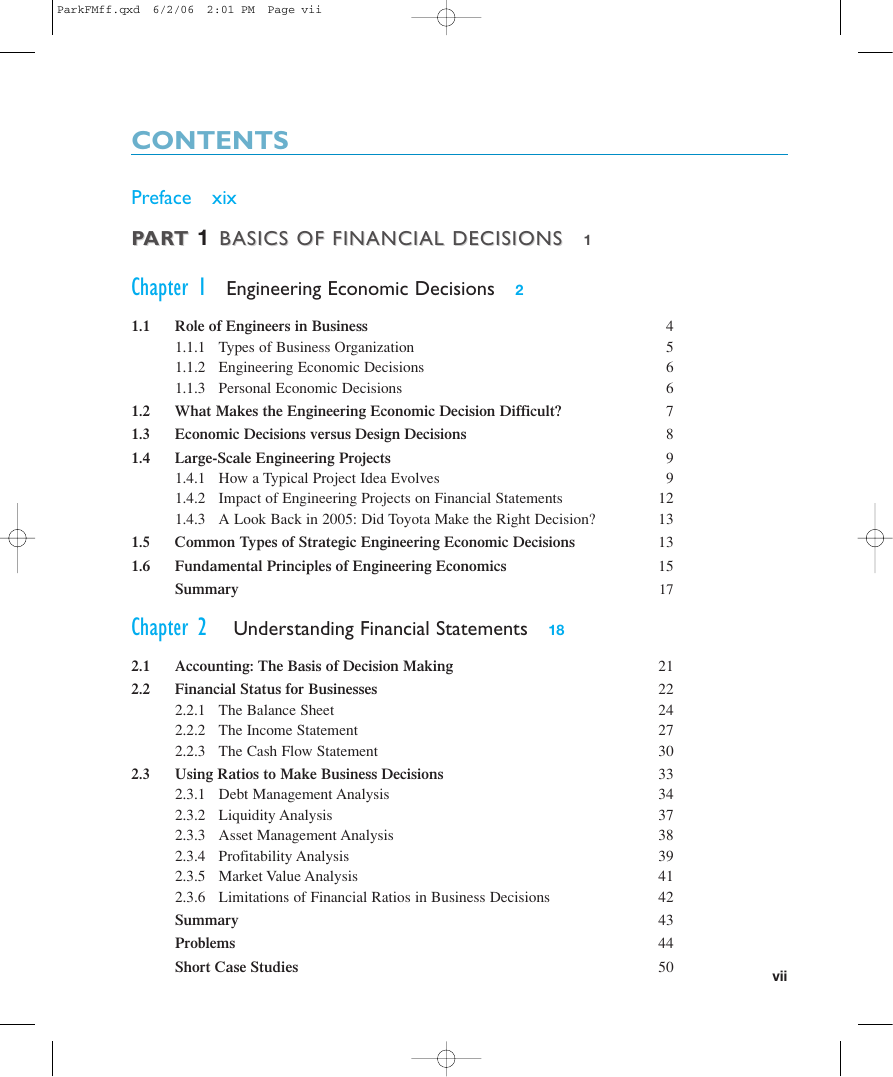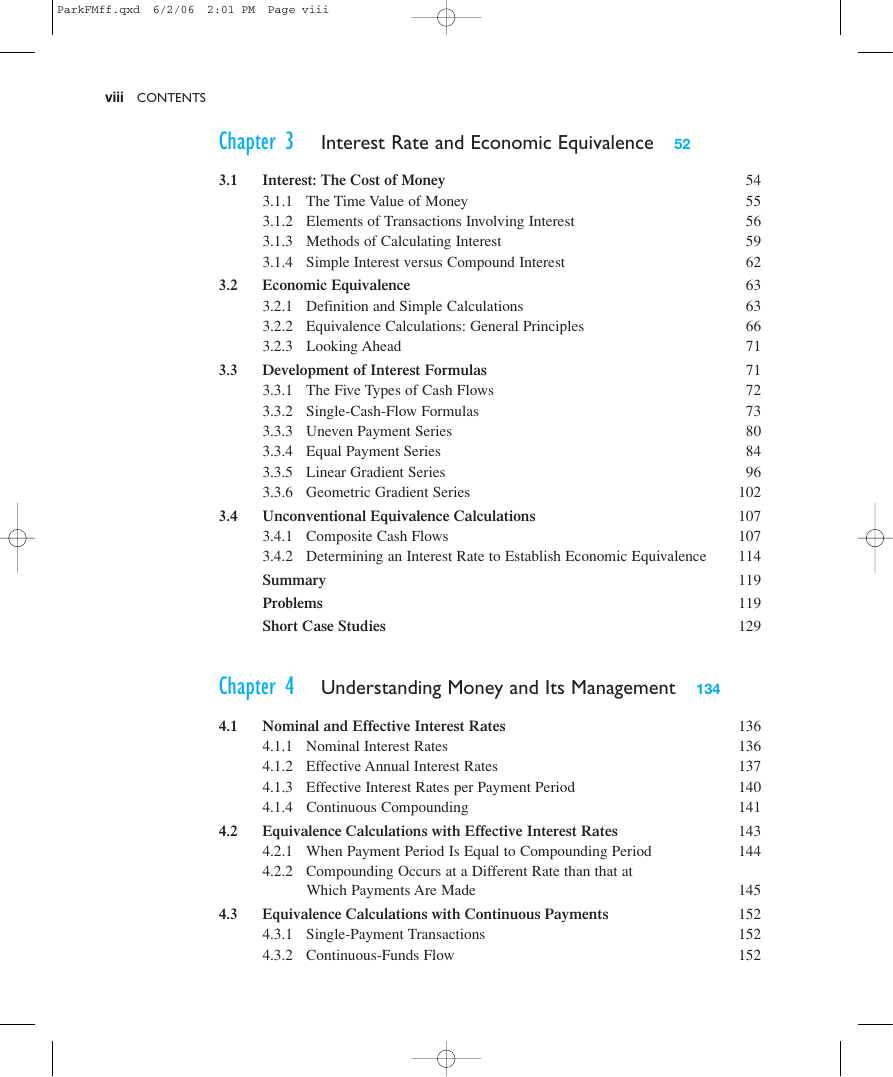ParkFMff.qxd 6/2/06 2:01 PM Page i
C o n t e m p o r a r y
Engineering
Economics
�
ParkFMff.qxd 6/2/06 2:01 PM Page ii
�
ParkFMff.qxd 6/2/06 2:01 PM Page iii
C o n t e m p o r a r y
Engineering
Economics
F o u r t h E d i t i o n
Chan S. Park
Depar tment of Industr ial
and Systems Engineer ing
Aubur n Univer sity
Upper Saddle River, NJ 07458
�
ParkFMff.qxd 6/2/06 2:01 PM Page iv
Library of Congress Cataloging-in-Publication Data on File
Vice President and Editorial Director, ECS: Marcia J. Horton
Senior Editor: Holly Stark
Editorial Assistant: Nicole Kunzmann
Executive Managing Editor: Vince O’Brien
Managing Editor: David A. George
Production Editor: Scott Disanno
Director of Creative Services: Paul Belfanti
Creative Director: Juan López
Art Director: Heather Scott
Interior and Cover Designer: Tamara Newnam
Art Editor: Xiaohong Zhu
Manufacturing Manager: Alexis Heydt-Long
Manufacturing Buyer: Lisa McDowell
Marketing Manager: Tim Galligan
© 2007 by Pearson Education, Inc.
Pearson Prentice Hall
Upper Saddle River, New Jersey 07458
All rights reserved. No part of this book may be reproduced, in any form or by any means
without permission in writing from the publisher.
The author and publisher of this book have used their best efforts in preparing this book. These
efforts include the development, research, and testing of the theories and programs to determine
their effectiveness. The author and publisher make no warranty of any kind, expressed or
implied, with regard to these programs or the documentation contained in this book. The author
and publisher shall not be liable in any event for incidental or consequential damages in connec-
tion with, or arising out of, the furnishing, performance, or use of these programs.
Printed in the United States of America
10
9
8
7
6
5
4
3
2
1
ISBN 0-13-187628-7
Pearson Education Ltd., London
Pearson Education Australia Pte. Ltd., Sydney
Pearson Education Singapore, Pte. Ltd.
Pearson Education North Asia Ltd., Hong Kong
Pearson Education Canada, Inc., Toronto
Pearson Educación de Mexico, S.A. de C.V.
Pearson Education–Japan, Tokyo
Pearson Education Malaysia, Ptd. Ltd.
Pearson Education, Inc., Upper Saddle River, New Jersey
�
ParkFMff.qxd 6/2/06 2:01 PM Page v
To my wife, Kim (Inkyung); and my children, Michael and Edward
�
ParkFMff.qxd 6/2/06 2:01 PM Page vi
�
ParkFMff.qxd 6/2/06 2:01 PM Page vii
CONTENTS
Preface xix
PPARART T 1 BBASICS OF FINANCIAL DECISIONS
ASICS OF FINANCIAL DECISIONS
1
Chapter 1 Engineering Economic Decisions
1.1
Role of Engineers in Business
1.1.1 Types of Business Organization
1.1.2 Engineering Economic Decisions
1.1.3 Personal Economic Decisions
2
1.2 What Makes the Engineering Economic Decision Difficult?
1.3
1.4
Economic Decisions versus Design Decisions
Large-Scale Engineering Projects
1.4.1 How a Typical Project Idea Evolves
1.4.2 Impact of Engineering Projects on Financial Statements
1.4.3 A Look Back in 2005: Did Toyota Make the Right Decision?
Common Types of Strategic Engineering Economic Decisions
Fundamental Principles of Engineering Economics
Summary
1.5
1.6
18
2.3
Chapter 2 Understanding Financial Statements
2.1
2.2
Accounting: The Basis of Decision Making
Financial Status for Businesses
2.2.1 The Balance Sheet
2.2.2 The Income Statement
2.2.3 The Cash Flow Statement
Using Ratios to Make Business Decisions
2.3.1 Debt Management Analysis
2.3.2 Liquidity Analysis
2.3.3 Asset Management Analysis
2.3.4 Profitability Analysis
2.3.5 Market Value Analysis
2.3.6 Limitations of Financial Ratios in Business Decisions
Summary
Problems
Short Case Studies
4
5
6
6
7
8
9
9
12
13
13
15
17
21
22
24
27
30
33
34
37
38
39
41
42
43
44
50
vii
�
ParkFMff.qxd 6/2/06 2:01 PM Page viii
viii CONTENTS
Chapter 3
3.1
3.2
3.3
3.4
4.2
4.3
Interest Rate and Economic Equivalence
52
Interest: The Cost of Money
3.1.1 The Time Value of Money
3.1.2 Elements of Transactions Involving Interest
3.1.3 Methods of Calculating Interest
3.1.4 Simple Interest versus Compound Interest
Economic Equivalence
3.2.1 Definition and Simple Calculations
3.2.2 Equivalence Calculations: General Principles
3.2.3 Looking Ahead
Development of Interest Formulas
3.3.1 The Five Types of Cash Flows
3.3.2 Single-Cash-Flow Formulas
3.3.3 Uneven Payment Series
3.3.4 Equal Payment Series
3.3.5 Linear Gradient Series
3.3.6 Geometric Gradient Series
Unconventional Equivalence Calculations
3.4.1 Composite Cash Flows
3.4.2 Determining an Interest Rate to Establish Economic Equivalence
Summary
Problems
Short Case Studies
134
Chapter 4 Understanding Money and Its Management
4.1
Nominal and Effective Interest Rates
4.1.1 Nominal Interest Rates
4.1.2 Effective Annual Interest Rates
4.1.3 Effective Interest Rates per Payment Period
4.1.4 Continuous Compounding
Equivalence Calculations with Effective Interest Rates
4.2.1 When Payment Period Is Equal to Compounding Period
4.2.2 Compounding Occurs at a Different Rate than that at
Which Payments Are Made
Equivalence Calculations with Continuous Payments
4.3.1 Single-Payment Transactions
4.3.2 Continuous-Funds Flow
54
55
56
59
62
63
63
66
71
71
72
73
80
84
96
102
107
107
114
119
119
129
136
136
137
140
141
143
144
145
152
152
152
�
















 2023年江西萍乡中考道德与法治真题及答案.doc
2023年江西萍乡中考道德与法治真题及答案.doc 2012年重庆南川中考生物真题及答案.doc
2012年重庆南川中考生物真题及答案.doc 2013年江西师范大学地理学综合及文艺理论基础考研真题.doc
2013年江西师范大学地理学综合及文艺理论基础考研真题.doc 2020年四川甘孜小升初语文真题及答案I卷.doc
2020年四川甘孜小升初语文真题及答案I卷.doc 2020年注册岩土工程师专业基础考试真题及答案.doc
2020年注册岩土工程师专业基础考试真题及答案.doc 2023-2024学年福建省厦门市九年级上学期数学月考试题及答案.doc
2023-2024学年福建省厦门市九年级上学期数学月考试题及答案.doc 2021-2022学年辽宁省沈阳市大东区九年级上学期语文期末试题及答案.doc
2021-2022学年辽宁省沈阳市大东区九年级上学期语文期末试题及答案.doc 2022-2023学年北京东城区初三第一学期物理期末试卷及答案.doc
2022-2023学年北京东城区初三第一学期物理期末试卷及答案.doc 2018上半年江西教师资格初中地理学科知识与教学能力真题及答案.doc
2018上半年江西教师资格初中地理学科知识与教学能力真题及答案.doc 2012年河北国家公务员申论考试真题及答案-省级.doc
2012年河北国家公务员申论考试真题及答案-省级.doc 2020-2021学年江苏省扬州市江都区邵樊片九年级上学期数学第一次质量检测试题及答案.doc
2020-2021学年江苏省扬州市江都区邵樊片九年级上学期数学第一次质量检测试题及答案.doc 2022下半年黑龙江教师资格证中学综合素质真题及答案.doc
2022下半年黑龙江教师资格证中学综合素质真题及答案.doc